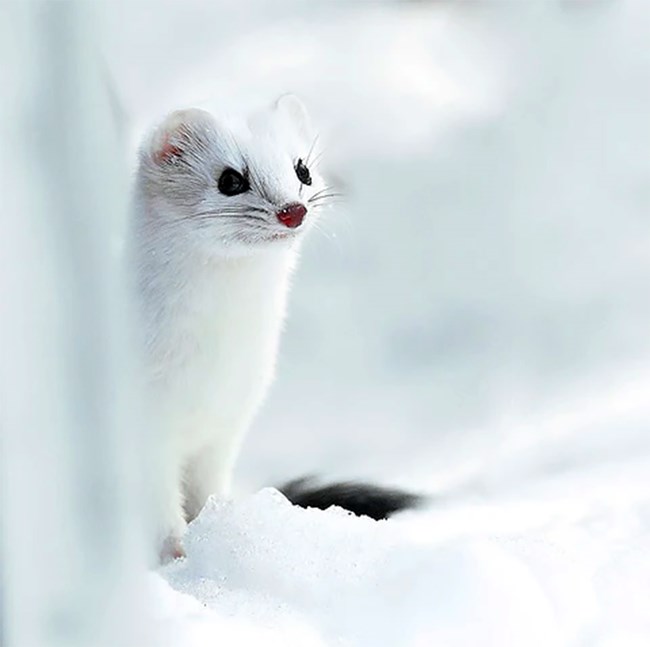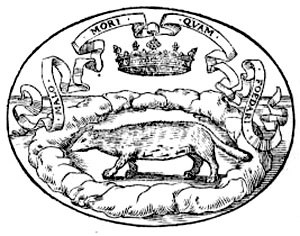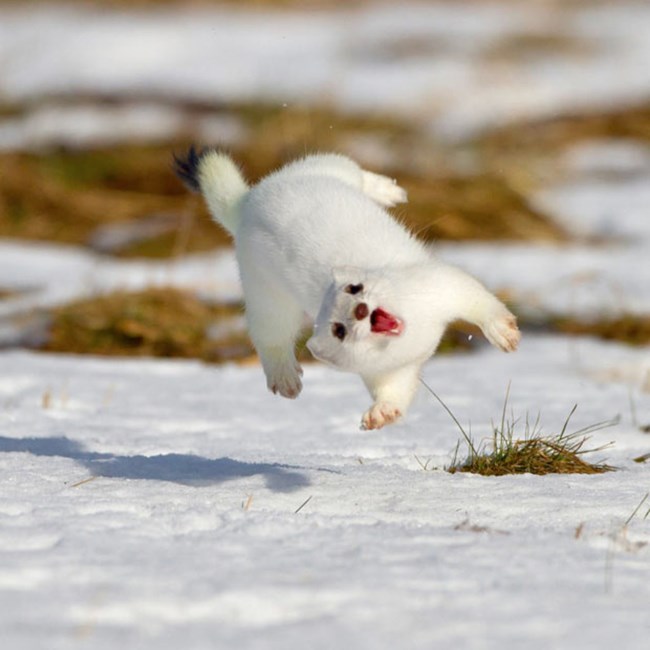Last updated: August 15, 2021
Article
NETN Species Spotlight - Short-tailed Weasel


I doubt anyone has ever been thanked for hurling the epithet “weasel” at someone. But maybe they should be. The weasel family is highly resourceful, ambitious, courageous, agile, energetic, and downright adorable in many instances. The short-tailed weasel was even a symbol of purity with a winter pelage so highly prized it adorned the robes and outfits of Byzantine emperors and European kings and queens for centuries. Perhaps an appropriate response would be “A weasel you say? Well I thank you good sir!” [accompanied by a bow and an appropriately exaggerated arm flourish].
A Seasonal Coat for this Stoat.
During the warmer months of the year, this weasel is a mix of light brown fur above with a white-colored belly, neck, feet, and chin below. The black-tip on the tail is kept year-round and is thought to help them avoid capture from predators, especially hawks and owls, who are distracted by the wildly-whipping black tip. It is these white, black-tipped winter tails that were used to decorate rugs, robes, and other garments of royalty for hundreds of years.
When the short-tailed weasel has donned its white winter coat for the season, it is more often referred to as an “ermine” or being “in ermine” - though sometimes this is only in reference to the white fur itself. To muddy the waters yet further, this weasel is also known as a stoat across much of its range in Europe, or even Bonaparte’s weasel, and historically - the somewhat contradictory Royal Armenian Rat in Greece.

Death before Defilement!
The weasel has suffered an undeserved duplicitous reputation by people over the centuries, being simultaneously seen as virtuous and vile. For several centuries in many European countries it was considered an unbesmirchable symbol of purity. In one of the more outlandish legends, it was said that hunters hoping to capture an ermine for its highly prized white fur need only smear the entrance of its lair with mud, then “release the hounds” and begin the hunt. The exhausted ermine would try to retreat to its den after a long chase only to find the entranceway tarnished with dirty earth-mud (gross...). Refusing to let its pristine coat be sullied by such disgusting filth, the ermine would turn to honorably face its pursuers and gladly accept death. An animal of such pure spirit and heart, it became associated with phrases like “Death before Defilement!” and “Death rather than Dishonor!” Yeah, sounds totally legit.
In traditional Irish mythology however, ermines were not viewed as highly. They were noxious animals prone to thieving, with saliva capable of poisoning a grown man. A chance encounter with an ermine on the road was a sure sign of ill fortune. Luckily, one could counteract the bad mojo by greeting the ermine as a friendly neighbor.
Silly as these traditions may seem to us today, modern western culture attaches at least as much baggage to weasel lore as any historic one. We have such low regard for the species that “weasel words” are those that a speaker uses to avoid being forthright, and someone who is a weasel is “a dishonest person who cannot be trusted.” The word “weasel” has even been turned into a derogatory verb, as to “weasel your way out” of something is to find a deceitful path for avoiding it. If any animal was ever in need of a modern day renaissance of reputation, it’s the much-maligned, misunderstood weasel.
The Tell-tale Tails.
There are many species of mustelids (scientific name for weasels) that live in the North America. You are unlikely to confuse an ermine for an otter, skunk, or fisher. But several other closely related species may give you pause at first glance. Mink are dark-chocolate brown year-round, and are most associated with rivers and streams. They are also a bit more robust than their smaller weasel cousins. Another is the least weasel. As its name suggests it is the smallest of the group, averaging only about 7 inches in length from tip to tail. If you are seeing your animal in the Northeast, you can rule them out as they only live west and north of here. A bit more challenging to distinguish - as their body length can overlap that of the ermine - is the aptly named long-tailed weasel. If you can get a glimpse of the tail, you should be able to distinguish it from the ermine. The long-tailed’s trailer is nearly equal the length of its body, while the erstwhile ermine’s end-hugger is closer to half the length of its body. Head to tail, adult ermine are 7 to 17 inches in length and weigh a feathery 2.1-3.9 ounces. Females have a body-width only about the girth of about that of a typical tube of toothpaste. All the more impressive when you consider the size of some of the animals they hunt.

Stay Hungry, My Friend
Weasels have a body form well suited to chasing down their prey. Long and slim, with short legs, long necks, and a small triangular head with rounded ears set low on the skull. This allows them to pursue their smaller prey through grasses, up trees, across rivers, in snow, and directly into their own tunnels and dens. Mice, voles, rats, chipmunks, shrews, frogs, lizards, small snakes, birds, insects and earthworms make up the bulk of their diet, but they are capable of taking down prey as much as 10-times their weight including rabbits and hares, woodchucks, domestic ducks and chickens, and an occasional baby pig. The weasel grabs onto its prey, wraps its muscular body around the animal to immobilize it, and then delivers a single killing bite to the back of the head, puncturing the skull or spinal cord.
Stocking the Larder: Food Caching
Some animals carry their fat reserves for survival on their body proper - think bears and woodchucks. But the ermine need to stay lithe and thin in order to be able to pursue prey. Thus, these weasels store their energy reserves outside their bodies, through the practice of “food caching.” With their fast metabolisms, they must eat more food, at least 40% of their body weight a day, than other mammals of similar size. When prey are plenty, they will often kill more than they need at the immediate moment and then hide, or cache away, the extra to be consumed later. Dens have been found with dozens of mice and voles stashed away, which in colder climates can last for several days or more. It is well known that this instinct to kill more than needed sometimes leads to a killing frenzy, and when that happens in a domesticated chicken coop, it can lead to 50 or more dead chickens in a single night. Though it may appear to us to be a gluttonous wanton act of destruction, to the weasel’s mind it is merely stocking the larder for leaner times.

Deadly Cute. The Dance that Causes a Trance.
Weasels will sometime perform what appears to be a crazy “war dance” when approaching a prey animal. It is thought that the exaggerated twisting, hopping, and darting about disorients and perhaps even hypnotizes some prey species. The weasel gets ever closer until it is too late for the prey to get away, with the last hop landing on top of the animal quickly followed by the killing bite.
For more
- Watch an ermine hypnotize a rabbit with a “war dance.”

Tags
- acadia national park
- appalachian national scenic trail
- eleanor roosevelt national historic site
- home of franklin d roosevelt national historic site
- marsh - billings - rockefeller national historical park
- minute man national historical park
- morristown national historical park
- saint-gaudens national historical park
- salem maritime national historical park
- saratoga national historical park
- saugus iron works national historic site
- vanderbilt mansion national historic site
- weir farm national historical park
- species spotlight
- netn
- inventory and monitoring division
- ermine
- weasel
- mammals
- winter
